Sigma 120-300mm f/2.8 DG OS HSM S Lens Review
Sigma 120-300mm f/2.8 DG OS HSM Performance
At 120mm, sharpness in the centre of the frame approaches excellent levels at maximum aperture. Clarity towards the edges of the frame lags behind somewhat at this setting, falling just short of good levels of sharpness. Stopping down the aperture to between f/5.6 and f/8 results in excellent sharpness across the frame for this focal length.Zooming to 180mm results in sharpness across the frame evening a little at maximum aperture, with the clarity in the centre approaching excellent, while very good levels of clarity are achieved towards the edges of the frame. Stopping down the aperture to between f/4 and f/8 results in excellent sharpness across the frame at this focal length.
Finally, at 300mm, overall sharpness is reduced, but the lens is still very usable at all apertures. At f/2.8 clarity approaches very good levels across the frame. With the aperture stopped down to between f/4 and f/8 sharpness exceeds very good levels across the frame.
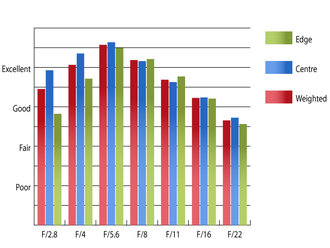 MTF@120mm | 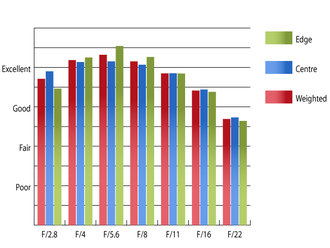 MTF@180mm |
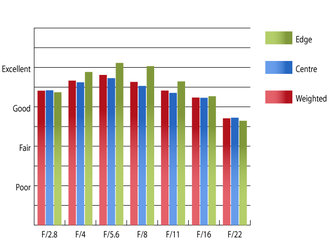 MTF@300mm | How to read our chartsThe blue column represents readings from the centre of the picture frame at the various apertures and the green is from the edges. Averaging them out gives the red weighted column.The scale on the left side is an indication of actual image resolution. The taller the column, the better the lens performance. Simple. For this review, the lens was tested on a Canon EOS 5D MkIII using Imatest. |
Chromatic aberrations are very well controlled, with fringing remaining very low towards the edges of the frame at all zoom settings. CAs are at their strongest at 120mm and maximum aperture, where half a pixel width is just exceeded at f/2.8. This low level of fringing should pose few issues, even with images that contain high contrast edges near the edges of the frame.
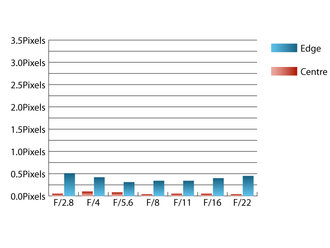 CA@120mm | 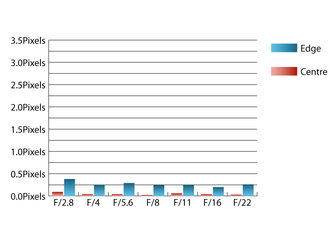 CA@180mm |
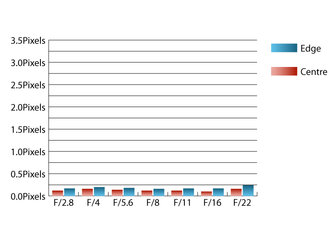 CA@300mm | How to read our chartsChromatic aberration is the lens' inability to focus on the sensor or film all colours of visible light at the same point. Severe chromatic aberration gives a noticeable fringing or a halo effect around sharp edges within the picture. It can be cured in software.Apochromatic lenses have special lens elements aspheric, extra-low dispersion etc. to minimize the problem, hence they usually cost more. For this review, the lens was tested on a Canon EOS 5D MkIII using Imatest. |
As you may expect from a fast aperture telephoto lens, falloff of illumination towards the corners can be spotted quite easily. Even with the corners being 1.3 stops darker than the image centre at 120mm and 1.8 stops darker at 300mm, this level is quite low for a lens of this type and visually uniform illumination is achieved with the aperture stopped down to f/5.6 throughout the zoom range.
Distortion is so mild at either end of the zoom range that it will be hard to spot with the naked eye, Imatest managed to detect only 0.0225% barrel distortion at 120mm and 0.959% pincushion distortion at 300mm. These low levels of distortion should rarely need correction, but if they do then is should be relatively straightforward to do so, as the distortion pattern is uniform across the frame.
A deep circular hood is supplied with the lens, which does a great job of shading the lens from extraneous light that may cause loss of contrast or flare. Contrast is good, even when shooting into the light.
Add your message
Login required
Please login here or if you've not registered, you can register here. Registering is safe, quick and free.
Please login here or if you've not registered, you can register here. Registering is safe, quick and free.
photodo Stats
1102 lenses
428 MTF tests
74 in-depth photodo reviews
100+ users join each day
Help the lens community by reviewing or rating a lens today via our lens search
428 MTF tests
74 in-depth photodo reviews
100+ users join each day
Help the lens community by reviewing or rating a lens today via our lens search
Latest Lens Reviews
- Chinon 28mm f/2.8 Vintage Lens Review
- Canon EF 70-200mm f/4L IS II USM Lens Review
- Samyang AF 85mm f/1.4 EF Review
- Sigma 70mm f/2.8 DG Macro Art Review
- Samyang AF 24mm f/2.8 FE Review
- Meike 50mm f/1.7 Review
- Tamron 70-210mm f/4 Di VC USD Review
- Lensbaby Burnside 35mm f/2.8 Review
- Asahi Super Takumar 50mm f/1.4 Review
- Asahi Super-Multi-Coated Takumar 135mm f/3.5 Review
